Building in Bushfire Prone Areas: Case Studies of Australian Bushfires
VerifiedAdded on 2023/06/08
|7
|1513
|103
Report
AI Summary
This report delves into the critical topic of building in bushfire-prone areas, focusing on two significant Australian bushfires: the Black Saturday fire of 2009 in Victoria and the Wye River/Separation Creek fire of 2015. The report examines the devastating impact of these events, including loss of life, property damage, and the factors contributing to the fires' spread. It analyzes the effectiveness of building codes, fire safety measures, and government policies, such as the 'stay or leave' policy, in mitigating bushfire risks. The report highlights the importance of fire-resistant construction materials, fuel load management, and community preparedness. It also critiques existing risk management systems and identifies areas for improvement in building standards and public awareness to enhance resilience in bushfire-prone regions. Furthermore, it emphasizes the role of architects and government in making fire-resistant building practices accessible to the general public. This report aims to provide valuable insights for policymakers, architects, and residents in bushfire-prone areas, offering strategies to reduce the impact of future wildfires and protect communities.
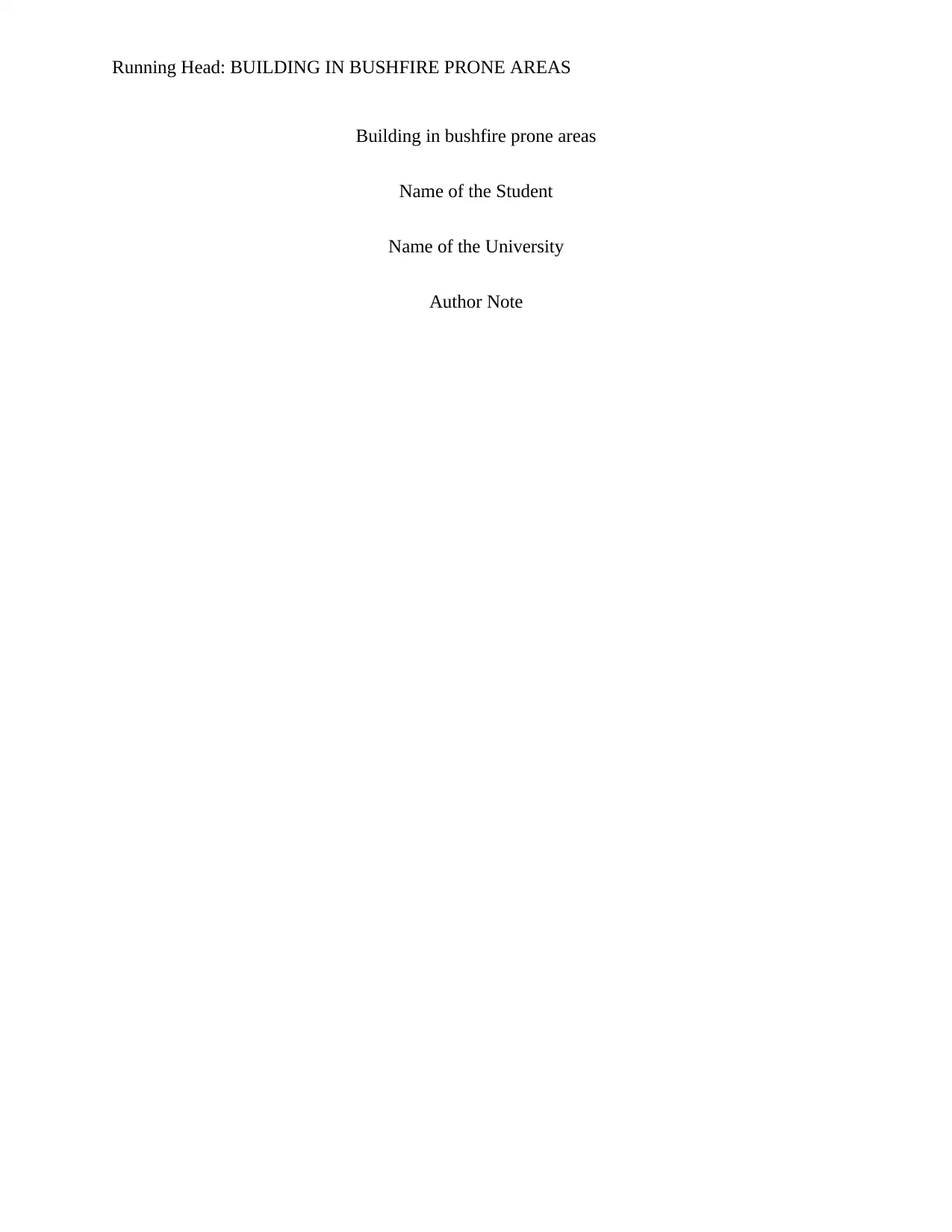
Running Head: BUILDING IN BUSHFIRE PRONE AREAS
Building in bushfire prone areas
Name of the Student
Name of the University
Author Note
Building in bushfire prone areas
Name of the Student
Name of the University
Author Note
Paraphrase This Document
Need a fresh take? Get an instant paraphrase of this document with our AI Paraphraser

1BUILDING IN BUSHFIRE PRONE AREAS
Topic- Victoria Black Saturday bushfire in the year 2009, Australia.
Australia, especially south Australia has been examined to be highly wildfire prone area
due to the Mediterranean type of climate in this country. In the year 2009, on 7th February, a
bushfire ravished almost the entire city of Victoria referred to as the Black Saturday. This fire
was one of the most tragic events in the history of Australia as it flamed almost 173 people and
injured more than 100 (The Sydney Morning Herald 2009). A major part of the country got
burnt down with a minimum number of 2,029 houses and 3,500 constructions in sum.
Newspapers, media, televisions were full of the news of the death tolls and the devastating
pictures showing that Melbourne, the capital of the state was highly damaged. There were other
parts of the country too which underwent great loss including Narbethong, Marysville,
Strawmen, Kinglake and Flower dale (The Sydney Morning Herald 2009). Some of the Victorian
hamlets such as Callgnee, Humvale, Wandong and Koornalla also faced extreme disaster. Each
town suffered from loss of people and massive burns. As a whole, almost 78 towns got affected
and more than 7,500 people left their homes burning behind (The Sydney Morning Herald 2009).
The reason behind such deplorable condition can be traced back to the heat waves and
extreme temperature (45 degrees Celsius) in the month of January, exactly before the event. The
dry and hot weather of Australia crated a slow pressure on the tropical areas and the countryside
dry bushes consequently caught fire. This short period is addressed to be the hottest time
Australia had ever experienced. The series of bush burning started with the Gipplesland area of
Victoria and spread frantically touching the neighboring lands. In order to survive in a bushfire
prone area, the best way is not staying within 500 miles of the land. However, still if one is to
build house in such area, some regulations are supposed to be abide by to stay unaffected from
Topic- Victoria Black Saturday bushfire in the year 2009, Australia.
Australia, especially south Australia has been examined to be highly wildfire prone area
due to the Mediterranean type of climate in this country. In the year 2009, on 7th February, a
bushfire ravished almost the entire city of Victoria referred to as the Black Saturday. This fire
was one of the most tragic events in the history of Australia as it flamed almost 173 people and
injured more than 100 (The Sydney Morning Herald 2009). A major part of the country got
burnt down with a minimum number of 2,029 houses and 3,500 constructions in sum.
Newspapers, media, televisions were full of the news of the death tolls and the devastating
pictures showing that Melbourne, the capital of the state was highly damaged. There were other
parts of the country too which underwent great loss including Narbethong, Marysville,
Strawmen, Kinglake and Flower dale (The Sydney Morning Herald 2009). Some of the Victorian
hamlets such as Callgnee, Humvale, Wandong and Koornalla also faced extreme disaster. Each
town suffered from loss of people and massive burns. As a whole, almost 78 towns got affected
and more than 7,500 people left their homes burning behind (The Sydney Morning Herald 2009).
The reason behind such deplorable condition can be traced back to the heat waves and
extreme temperature (45 degrees Celsius) in the month of January, exactly before the event. The
dry and hot weather of Australia crated a slow pressure on the tropical areas and the countryside
dry bushes consequently caught fire. This short period is addressed to be the hottest time
Australia had ever experienced. The series of bush burning started with the Gipplesland area of
Victoria and spread frantically touching the neighboring lands. In order to survive in a bushfire
prone area, the best way is not staying within 500 miles of the land. However, still if one is to
build house in such area, some regulations are supposed to be abide by to stay unaffected from
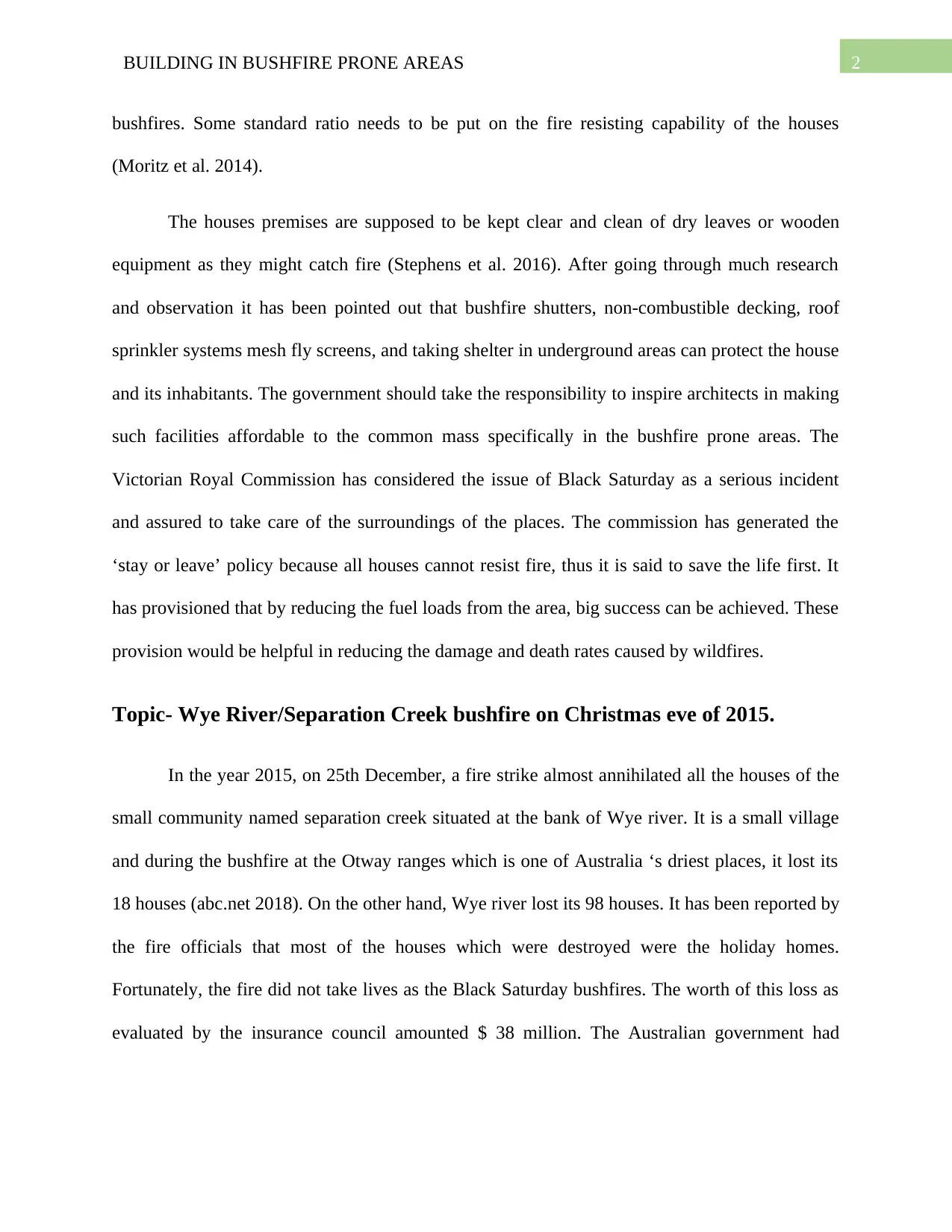
2BUILDING IN BUSHFIRE PRONE AREAS
bushfires. Some standard ratio needs to be put on the fire resisting capability of the houses
(Moritz et al. 2014).
The houses premises are supposed to be kept clear and clean of dry leaves or wooden
equipment as they might catch fire (Stephens et al. 2016). After going through much research
and observation it has been pointed out that bushfire shutters, non-combustible decking, roof
sprinkler systems mesh fly screens, and taking shelter in underground areas can protect the house
and its inhabitants. The government should take the responsibility to inspire architects in making
such facilities affordable to the common mass specifically in the bushfire prone areas. The
Victorian Royal Commission has considered the issue of Black Saturday as a serious incident
and assured to take care of the surroundings of the places. The commission has generated the
‘stay or leave’ policy because all houses cannot resist fire, thus it is said to save the life first. It
has provisioned that by reducing the fuel loads from the area, big success can be achieved. These
provision would be helpful in reducing the damage and death rates caused by wildfires.
Topic- Wye River/Separation Creek bushfire on Christmas eve of 2015.
In the year 2015, on 25th December, a fire strike almost annihilated all the houses of the
small community named separation creek situated at the bank of Wye river. It is a small village
and during the bushfire at the Otway ranges which is one of Australia ‘s driest places, it lost its
18 houses (abc.net 2018). On the other hand, Wye river lost its 98 houses. It has been reported by
the fire officials that most of the houses which were destroyed were the holiday homes.
Fortunately, the fire did not take lives as the Black Saturday bushfires. The worth of this loss as
evaluated by the insurance council amounted $ 38 million. The Australian government had
bushfires. Some standard ratio needs to be put on the fire resisting capability of the houses
(Moritz et al. 2014).
The houses premises are supposed to be kept clear and clean of dry leaves or wooden
equipment as they might catch fire (Stephens et al. 2016). After going through much research
and observation it has been pointed out that bushfire shutters, non-combustible decking, roof
sprinkler systems mesh fly screens, and taking shelter in underground areas can protect the house
and its inhabitants. The government should take the responsibility to inspire architects in making
such facilities affordable to the common mass specifically in the bushfire prone areas. The
Victorian Royal Commission has considered the issue of Black Saturday as a serious incident
and assured to take care of the surroundings of the places. The commission has generated the
‘stay or leave’ policy because all houses cannot resist fire, thus it is said to save the life first. It
has provisioned that by reducing the fuel loads from the area, big success can be achieved. These
provision would be helpful in reducing the damage and death rates caused by wildfires.
Topic- Wye River/Separation Creek bushfire on Christmas eve of 2015.
In the year 2015, on 25th December, a fire strike almost annihilated all the houses of the
small community named separation creek situated at the bank of Wye river. It is a small village
and during the bushfire at the Otway ranges which is one of Australia ‘s driest places, it lost its
18 houses (abc.net 2018). On the other hand, Wye river lost its 98 houses. It has been reported by
the fire officials that most of the houses which were destroyed were the holiday homes.
Fortunately, the fire did not take lives as the Black Saturday bushfires. The worth of this loss as
evaluated by the insurance council amounted $ 38 million. The Australian government had
⊘ This is a preview!⊘
Do you want full access?
Subscribe today to unlock all pages.

Trusted by 1+ million students worldwide
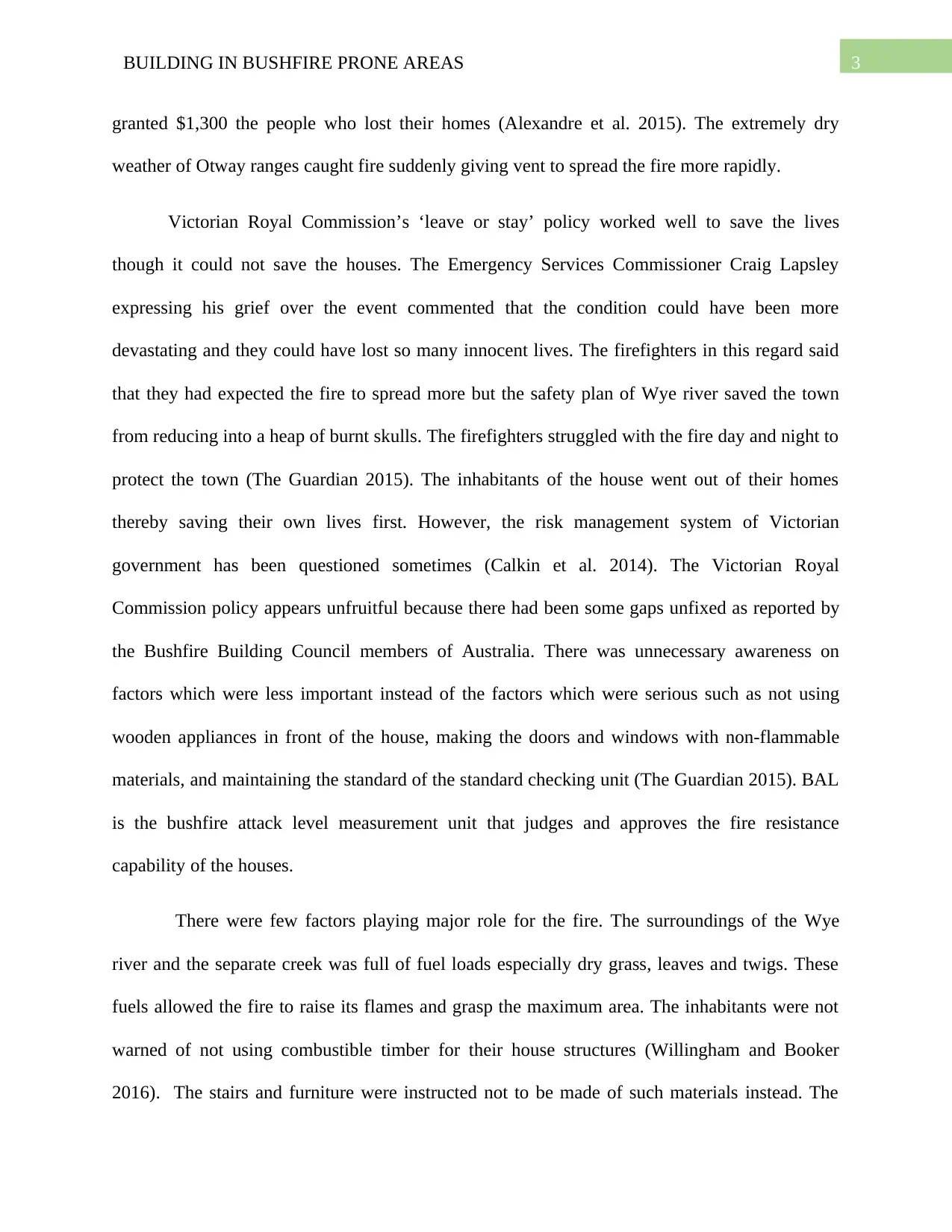
3BUILDING IN BUSHFIRE PRONE AREAS
granted $1,300 the people who lost their homes (Alexandre et al. 2015). The extremely dry
weather of Otway ranges caught fire suddenly giving vent to spread the fire more rapidly.
Victorian Royal Commission’s ‘leave or stay’ policy worked well to save the lives
though it could not save the houses. The Emergency Services Commissioner Craig Lapsley
expressing his grief over the event commented that the condition could have been more
devastating and they could have lost so many innocent lives. The firefighters in this regard said
that they had expected the fire to spread more but the safety plan of Wye river saved the town
from reducing into a heap of burnt skulls. The firefighters struggled with the fire day and night to
protect the town (The Guardian 2015). The inhabitants of the house went out of their homes
thereby saving their own lives first. However, the risk management system of Victorian
government has been questioned sometimes (Calkin et al. 2014). The Victorian Royal
Commission policy appears unfruitful because there had been some gaps unfixed as reported by
the Bushfire Building Council members of Australia. There was unnecessary awareness on
factors which were less important instead of the factors which were serious such as not using
wooden appliances in front of the house, making the doors and windows with non-flammable
materials, and maintaining the standard of the standard checking unit (The Guardian 2015). BAL
is the bushfire attack level measurement unit that judges and approves the fire resistance
capability of the houses.
There were few factors playing major role for the fire. The surroundings of the Wye
river and the separate creek was full of fuel loads especially dry grass, leaves and twigs. These
fuels allowed the fire to raise its flames and grasp the maximum area. The inhabitants were not
warned of not using combustible timber for their house structures (Willingham and Booker
2016). The stairs and furniture were instructed not to be made of such materials instead. The
granted $1,300 the people who lost their homes (Alexandre et al. 2015). The extremely dry
weather of Otway ranges caught fire suddenly giving vent to spread the fire more rapidly.
Victorian Royal Commission’s ‘leave or stay’ policy worked well to save the lives
though it could not save the houses. The Emergency Services Commissioner Craig Lapsley
expressing his grief over the event commented that the condition could have been more
devastating and they could have lost so many innocent lives. The firefighters in this regard said
that they had expected the fire to spread more but the safety plan of Wye river saved the town
from reducing into a heap of burnt skulls. The firefighters struggled with the fire day and night to
protect the town (The Guardian 2015). The inhabitants of the house went out of their homes
thereby saving their own lives first. However, the risk management system of Victorian
government has been questioned sometimes (Calkin et al. 2014). The Victorian Royal
Commission policy appears unfruitful because there had been some gaps unfixed as reported by
the Bushfire Building Council members of Australia. There was unnecessary awareness on
factors which were less important instead of the factors which were serious such as not using
wooden appliances in front of the house, making the doors and windows with non-flammable
materials, and maintaining the standard of the standard checking unit (The Guardian 2015). BAL
is the bushfire attack level measurement unit that judges and approves the fire resistance
capability of the houses.
There were few factors playing major role for the fire. The surroundings of the Wye
river and the separate creek was full of fuel loads especially dry grass, leaves and twigs. These
fuels allowed the fire to raise its flames and grasp the maximum area. The inhabitants were not
warned of not using combustible timber for their house structures (Willingham and Booker
2016). The stairs and furniture were instructed not to be made of such materials instead. The
Paraphrase This Document
Need a fresh take? Get an instant paraphrase of this document with our AI Paraphraser
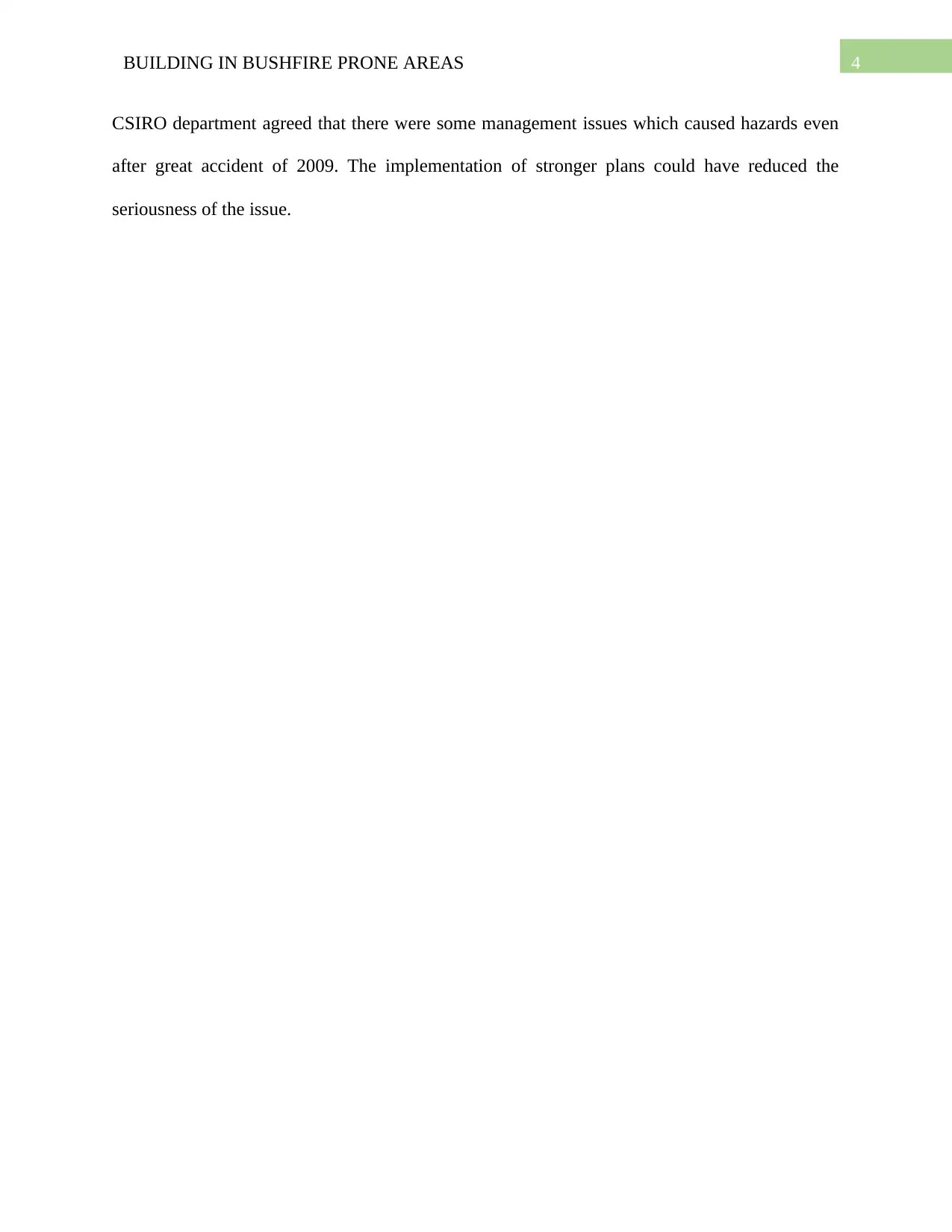
4BUILDING IN BUSHFIRE PRONE AREAS
CSIRO department agreed that there were some management issues which caused hazards even
after great accident of 2009. The implementation of stronger plans could have reduced the
seriousness of the issue.
CSIRO department agreed that there were some management issues which caused hazards even
after great accident of 2009. The implementation of stronger plans could have reduced the
seriousness of the issue.
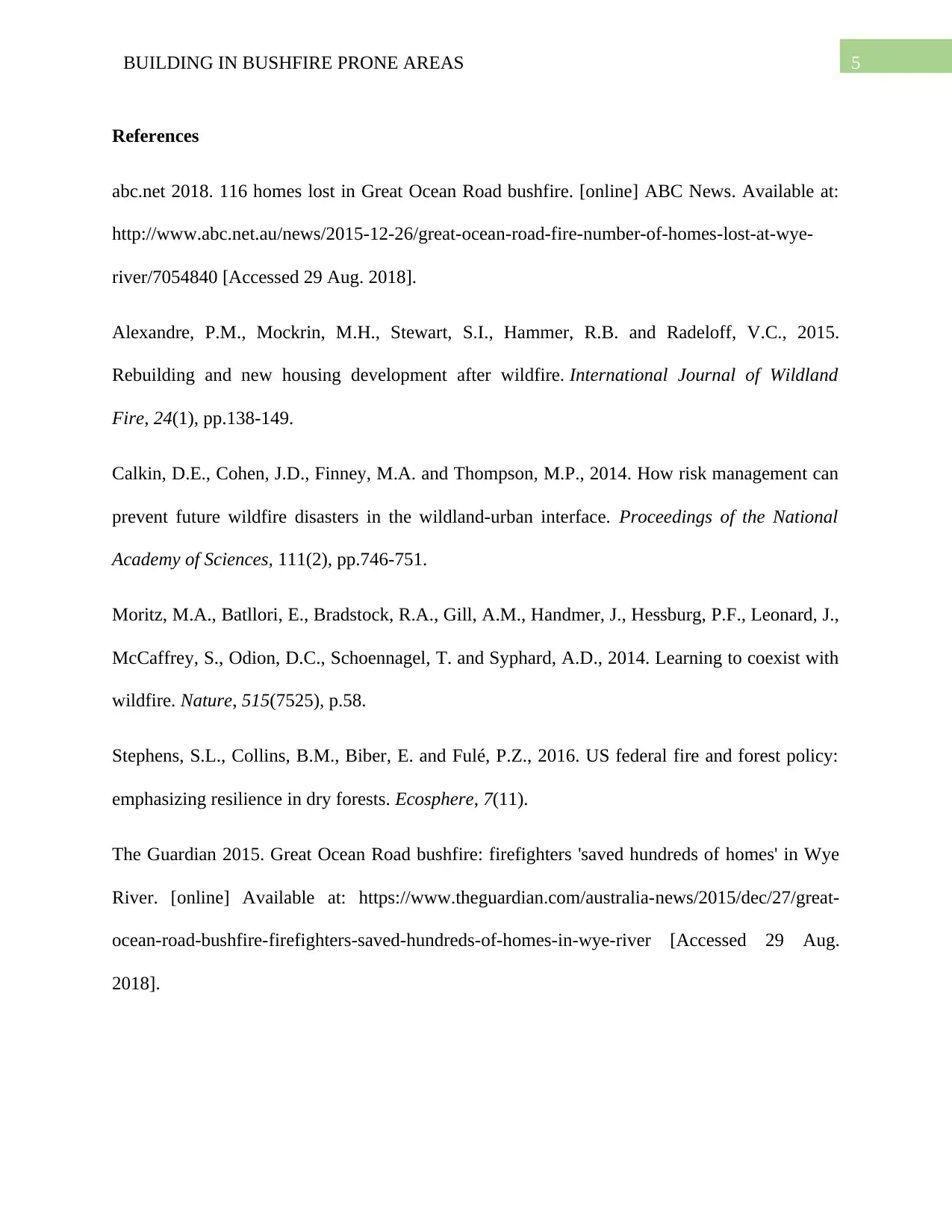
5BUILDING IN BUSHFIRE PRONE AREAS
References
abc.net 2018. 116 homes lost in Great Ocean Road bushfire. [online] ABC News. Available at:
http://www.abc.net.au/news/2015-12-26/great-ocean-road-fire-number-of-homes-lost-at-wye-
river/7054840 [Accessed 29 Aug. 2018].
Alexandre, P.M., Mockrin, M.H., Stewart, S.I., Hammer, R.B. and Radeloff, V.C., 2015.
Rebuilding and new housing development after wildfire. International Journal of Wildland
Fire, 24(1), pp.138-149.
Calkin, D.E., Cohen, J.D., Finney, M.A. and Thompson, M.P., 2014. How risk management can
prevent future wildfire disasters in the wildland-urban interface. Proceedings of the National
Academy of Sciences, 111(2), pp.746-751.
Moritz, M.A., Batllori, E., Bradstock, R.A., Gill, A.M., Handmer, J., Hessburg, P.F., Leonard, J.,
McCaffrey, S., Odion, D.C., Schoennagel, T. and Syphard, A.D., 2014. Learning to coexist with
wildfire. Nature, 515(7525), p.58.
Stephens, S.L., Collins, B.M., Biber, E. and Fulé, P.Z., 2016. US federal fire and forest policy:
emphasizing resilience in dry forests. Ecosphere, 7(11).
The Guardian 2015. Great Ocean Road bushfire: firefighters 'saved hundreds of homes' in Wye
River. [online] Available at: https://www.theguardian.com/australia-news/2015/dec/27/great-
ocean-road-bushfire-firefighters-saved-hundreds-of-homes-in-wye-river [Accessed 29 Aug.
2018].
References
abc.net 2018. 116 homes lost in Great Ocean Road bushfire. [online] ABC News. Available at:
http://www.abc.net.au/news/2015-12-26/great-ocean-road-fire-number-of-homes-lost-at-wye-
river/7054840 [Accessed 29 Aug. 2018].
Alexandre, P.M., Mockrin, M.H., Stewart, S.I., Hammer, R.B. and Radeloff, V.C., 2015.
Rebuilding and new housing development after wildfire. International Journal of Wildland
Fire, 24(1), pp.138-149.
Calkin, D.E., Cohen, J.D., Finney, M.A. and Thompson, M.P., 2014. How risk management can
prevent future wildfire disasters in the wildland-urban interface. Proceedings of the National
Academy of Sciences, 111(2), pp.746-751.
Moritz, M.A., Batllori, E., Bradstock, R.A., Gill, A.M., Handmer, J., Hessburg, P.F., Leonard, J.,
McCaffrey, S., Odion, D.C., Schoennagel, T. and Syphard, A.D., 2014. Learning to coexist with
wildfire. Nature, 515(7525), p.58.
Stephens, S.L., Collins, B.M., Biber, E. and Fulé, P.Z., 2016. US federal fire and forest policy:
emphasizing resilience in dry forests. Ecosphere, 7(11).
The Guardian 2015. Great Ocean Road bushfire: firefighters 'saved hundreds of homes' in Wye
River. [online] Available at: https://www.theguardian.com/australia-news/2015/dec/27/great-
ocean-road-bushfire-firefighters-saved-hundreds-of-homes-in-wye-river [Accessed 29 Aug.
2018].
⊘ This is a preview!⊘
Do you want full access?
Subscribe today to unlock all pages.

Trusted by 1+ million students worldwide
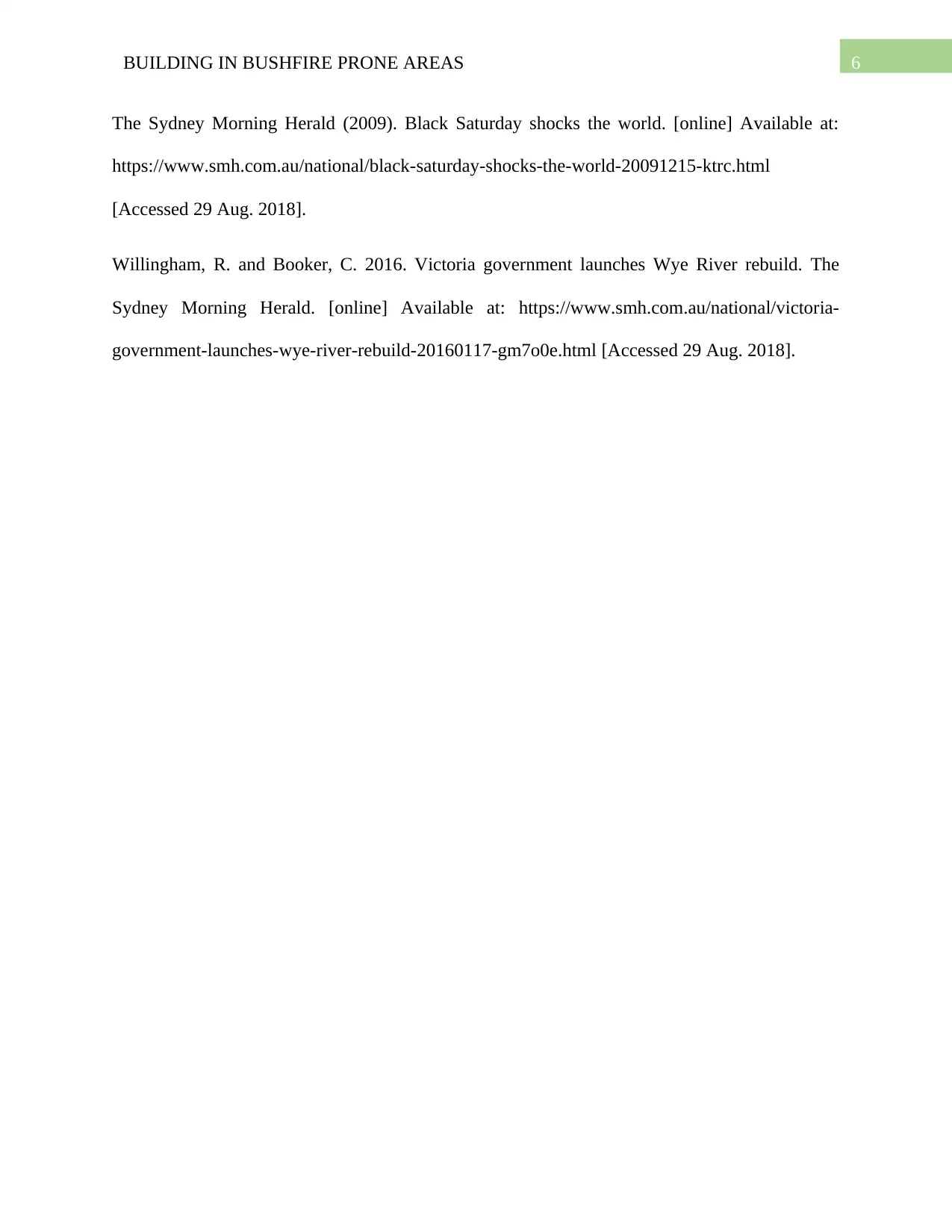
6BUILDING IN BUSHFIRE PRONE AREAS
The Sydney Morning Herald (2009). Black Saturday shocks the world. [online] Available at:
https://www.smh.com.au/national/black-saturday-shocks-the-world-20091215-ktrc.html
[Accessed 29 Aug. 2018].
Willingham, R. and Booker, C. 2016. Victoria government launches Wye River rebuild. The
Sydney Morning Herald. [online] Available at: https://www.smh.com.au/national/victoria-
government-launches-wye-river-rebuild-20160117-gm7o0e.html [Accessed 29 Aug. 2018].
The Sydney Morning Herald (2009). Black Saturday shocks the world. [online] Available at:
https://www.smh.com.au/national/black-saturday-shocks-the-world-20091215-ktrc.html
[Accessed 29 Aug. 2018].
Willingham, R. and Booker, C. 2016. Victoria government launches Wye River rebuild. The
Sydney Morning Herald. [online] Available at: https://www.smh.com.au/national/victoria-
government-launches-wye-river-rebuild-20160117-gm7o0e.html [Accessed 29 Aug. 2018].
1 out of 7
Related Documents
Your All-in-One AI-Powered Toolkit for Academic Success.
+13062052269
info@desklib.com
Available 24*7 on WhatsApp / Email
![[object Object]](/_next/static/media/star-bottom.7253800d.svg)
Unlock your academic potential
Copyright © 2020–2025 A2Z Services. All Rights Reserved. Developed and managed by ZUCOL.





